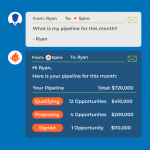AI Can Make Us All Dress Better. So Why Isn’t The Fashion Industry Using It More?
Fashion has always taken to the latest in trendy tech developments, from sparkly wearables and interactive dressing rooms to robots walking the Chanel runway. Increasingly, the industry is embracing AI and exploring how it can impact e-commerce productivity, retailer experiences, promotional campaigns, and even the clothes themselves.
As online shopping continues to grow, it’s imperative for companies to utilize tools that can help them attract (and keep) customers. AI can do that in a multitude of ways. It can serve as a communication method to update an audience on collection releases and product availability. It can provide interactive storytelling and unique digital experiences with the help of creative algorithms. It can strengthen e-commerce by tracking users’ preferences and giving them a customized shopping experience. These are all things the fashion world desperately wants—and needs.
The problem is, the industry hasn’t quite figured out how best to use AI. Eager to jump on the bandwagon, some companies have rolled out services that all too often led with the tech instead of the creative, resulting in stunted campaigns that were all flash, no substance. The chatbot—and AI foot soldier—has become the most common example of bland overuse.
The Basic Bot
Bots are a clever way to engage consumers and meet them on their platform of choice, be it Facebook, Slack, Skype, or a retailer website. Bots are everywhere because they are relatively simple conversational platforms that can replace some human-based customer service tasks. They’ve been successful when infused with creativity, humor, and actual resourcefulness. For instance, early reviews of Taco Bell’s Slack TacoBot, which allows hungry office workers to order lunch without taking their eyes off their instant messages, seem to agree that the tool feels consistent with the fast food chain’s cheeky personality.
Consistency is crucial when it comes to brand identity—and fashion is no exception. “You have to give this thing a personality that matches your brand and what you’re offering,” says Ryan Opina, VP of user experience at the agency Engine Digital. “It’s really easy to cross the line into spam.”
Avoiding that trap is especially important given that, according to Botanalytics, a firm that specializes in improving human-to-bot communication, 40% of people disengage after one interaction. “Right now, fashion brands are jumping to use [AI] and leverage it—to be the first to market with the technology, but not exactly using it as an expression of that specific brand,” says Ruth Bernstein, cofounder of YARD, an image-making and content-creation agency. “It’s easy to get carried away with, ‘Oh, we’re doing [bots] because we can.’”
So what does a successful fashion bot look like? Burberry got it right last fall, when the company launched a Facebook Messenger bot during London Fashion Week. The tool offered exclusive glimpses of the new collection prior to the runway debut and shared trivia related to the line’s inspiration. It then offered live customer service so that users could buy the clothes, which had been made available the same day as the Fashion Week show.
Bernstein, whose company works with clients such as John Varvatos, Etienne Aigner, David’s Bridal, and La Mer, says brands developing bots should consider basing them on what she calls a “brand muse,” or a character who epitomizes the brand. (A 2014 John Varvatos campaign was built around a “muse” known as the “rock and roll gentleman.”)
But even with those guideposts, nailing the right type of bot is easier said than done. It’s not hard to imagine a bot that represents Chanel’s creative director Karl Lagerfeld. It would reflect his taste, offer his recommendations, and maybe even speak in his snappy language. A LagerBot would be amusing, no doubt. But could it feel personal to the customer? Could it connect with the consumer? Could it make a transactional experience feel conversational without being cloying?
“It’s really hard,” Bernstein says. The YARD cofounder often finds herself asking two important questions when working on fashion campaigns: 1) What’s the actual benefit for the consumer; and 2) how does it serve and reinforce the tenets of the brand? “Sure, it can be innovative,” she says. “But is it right?”
Even if the bot displays an engaging personality, there’s still the possibility that consumers will find its actual functionality stale and predictable. You ask a question, get an answer, and then choose among three actions you can take as a result of that answer, like “ask another question,” “keep shopping,” or “request live assistance.”
“Everything about the experience now is about rails, it’s about being on a very specific pathway,” says Engine Digital’s Opina.
Then there are the nitty-gritty communication issues, such as natural language proficiency, comprehension, and processing. If you say you want to look “super hot,” it might just send you a picture of a wool sweatsuit. Bots can be frustratingly literal. “There’s been a huge interest because there’s so much talk about it,” says Opina. “But the practical benefit to it . . . you start to question whether it’s easier for [the consumer] to just go to the website and figure it out on [his or her] own.”
Practicality is what propelled David Fischer, founder and CEO of HighSnobiety, a website covering streetwear trends, to launch his Sneakers Bot on Facebook Messenger. His bot is a conveyer of information, promising consumers “lightning-fast sneaker updates from all your favorite brands.”
Fischer sees specialized chatbots as a direct way of staying in touch with a brand’s customer base. “It’s why a simple newsletter or email contact is still so important today.” A bot is even more effective, he argues, because it hits people where they likely already are: on Facebook. It’s customer service offered to millions of users at the same time.
Fischer began with sneakers because it’s a niche market with a passionate consumer base—die-hard “sneakerheads” with one too many pairs of Stan Smiths.
“We felt like the technology was perfect for that space because we could build a new loyal relationship with those fans who already visit our site every single day,” Fischer says. “We can deliver important news faster than ever before, and we can give them an entirely new experience around the sneaker in terms of sneaker news, purchases, and lifestyle.”
Fischer’s Sneaker Bot will inform you when cult favorites like ACNE or Kanye West release new lines, but it is a one-sided conversation. For example, if you tell it, “I want to buy pink sneakers,” it may well respond with a GIF of a confused Fresh Prince of Bel-Air. So yes, there are limits.
There’s also a fine line between helpful and downright annoying. “If you overuse this tool, you can alienate the user,” says Fischer. “But if you get these things right, it might actually be the most powerful communication tool of all.”
Custom Content And Crowdsourced Couture?
AI is more than just chatbots. The fashion scene has explored various ways to infuse machine learning with e-commerce initiatives. Engine Digital, for example, works with high-profile clients such as Lululemon and Kit and Ace, and they try to pinpoint one area where the brands can use AI effectively.
With Kit and Ace, the agency focused on blending e-commerce with tailored content. If a customer repeatedly gravitated toward blue items while browsing the website, that color would be prioritized for their next visit. The customer might also be presented with content specific to their location and closest city. If you log on in Vancouver, you will find a city guide and profiles of the city’s up-and-coming artists. “[Kit and Ace] really wanted to focus on the fact that it’s a global company, but at the same time focus on the local creative community,” Engine Digital’s Opina says.
As lines between art and technology continue to blur, there’s also potential for AI to weave itself into the actual work of producing clothing. Winston Binch, chief digital officer of Deutsch, the agency behind Slack’s TacoBot, sees opportunities for the industry to partner with tech giants such as IBM and Microsoft, which have invested in innovative ways to use their AI. If IBM Research can help 20th Century Fox create the first ever “cognitive movie trailer” (i.e., one cut together by AI), surely fashion houses could use AI to execute ambitious projects. It could help create crowdsourced collections or collections based on consumer trends. AI could help produce interactive streaming runway shows. It could even predict incoming fads.
“There’s a lot of expertise out there, and a lot of these scientists, they don’t really know what to do with it, from a branding and creative standpoint,” says Binch. “AI can do so much, but it still needs charisma, wit, and personality. And that’s where creativity comes in.”
A Melding Of The Minds
One of the biggest challenges for high-end fashion companies grappling with AI has been re-creating the sense of pampering that is synonymous with shopping in the luxury sector. “In the digital world, that’s very hard to replicate,” YARD’s Bernstein says.
But as AI progresses, there’s no reason the exclusive feeling of a Fifth Avenue boutique can’t be replicated on a brand’s website. Tech can stand in for the obsequious sales clerk and help you find the perfect gala gown by keeping track of your shopping history or Instagram likes. It’s about removing the effort and making it seamless, according to Bernstein.
There’s also the option of mixing AI with human intelligence. One startup infusing the two forces is Thread, a style service that depends on the fashion instincts of living, breathing stylists and an algorithm to help men shop.
Thread customers complete a short questionnaire and upload a few images of themselves. They’re then paired with a stylist who reviews the information and gets a feel for each client’s style. The stylist assembles the skeleton of an outfit using categories of garments (i.e., “chino pants,” “Oxford shirt”), then he or she uses Thread’s proprietary algorithm to sort through thousands of products and put together an outfit for purchase. The technology takes into account more than 50 elements of each user’s personal attributes—everything from general fashion preferences to specific body shape—to make personalized recommendations. There are 3.7 trillion different potential outfit combinations in Thread’s database, which means no two people will ever see the same ensemble. Users can improve the algorithm’s accuracy by rating items or providing feedback as specific as, “I don’t like pleated pants.”
“We’ve found that AI works best when it’s tempered by actual intelligence—from humans,” says Thread CEO Kieran O’Neill via email. “Our vision for Thread is to blend the best bits of a human stylist with the best bits of a computer to create something that’s better than either would be by itself.”
He might be right. Thread went from 50,000 clients to 500,000 in the last two years. O’Neill reports that by making the company’s algorithm 20 times more powerful in terms of its customization efforts, product sales from its e-commerce partners increased tenfold.
“We’ve seen a hugely increased propensity of first-time users to buy something, and growing site visits as well, all due to the continual fine-tuning of the personalization element,” he says.
While many brands focus on replicating the in-store experience online, Thread sees an opportunity to redefine digital shopping altogether. Why not just create your online dream store, where everything is customized just for you?
“Signing in to your account is effectively walking into a store where everything is in your size, in your budget, by your favorite brands, and approved by a stylist.” he says. “This is structurally impossible to do offline.”
The blend of human and AI might be the perfect fit until the technology matures and the industry sorts best practices. Until then, brands will continue to experiment, in search of the right tone and use for their customers’ needs. “In the early days of these new technologies and platforms, you have to take a chance,” says HighSnobiety’s Fischer.
Which sounds about right. Fashion is all about risk-taking, no?
Fast Company , Read Full Story
(50)














